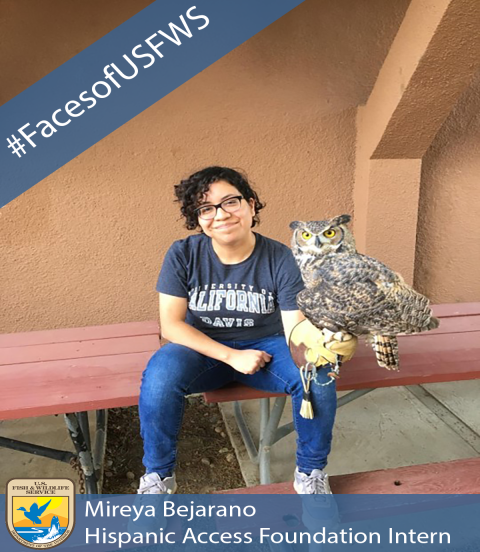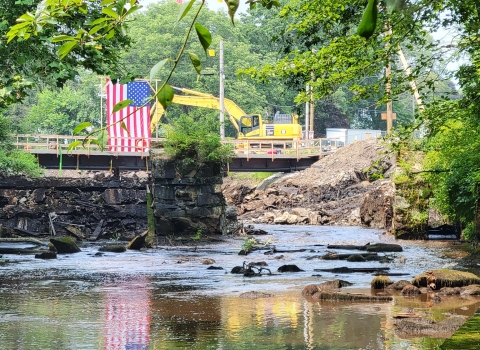Mireya Bejarano is a 2021 graduate of the University of California, Davis. She joined the U.S. Fish and Wildlife Service’s (Service) Ventura Fish and Wildlife Office in the summer of 2022 where she completed a biologist internship through the Hispanic Access Foundation (HAF). She is interviewed by public affairs specialist Vanessa Morales. Read more to learn about her time with the Service!
Vanessa Morales:Hey, Mireya! Can you tell me about your Hispanic Access Foundation internship?
Mireya Bejarano: Hi Vanessa. I started in mid-June of this year and the main projects I was working on was cleaning and formatting of BeachCOMBERs data. BeachCOMBERs is a citizen science program supported by the U.S. Fish and Wildlife Service, where trained volunteers will go out to the beach and survey for dead birds or marine animals. The volunteers will then input data like species and the condition it was found in into a mobile phone application. This data helps the science community understand the health of our coastlines.
My favorite part of citizen science programs is they connect people with their local environment. You get people who are not scientists contributing to important research and to care for our community and nature, which I think is really cool. Volunteers could be people who do not otherwise know much about wildlife, but because of the BeachCOMBERs program, they build their knowledge about beach ecosystems.
The other part of my internship was writing profiles for the public about federally protect species for our office’s website, including Indian knob mountainbalm, Ventura marsh Milk-Vetch, Ohlone tiger Beetle Nipomo Mesa lupine, and for the unarmored threespine stickleback. So yeah, my internship was half consolidating and organizing BeachCOMBERs data andwriting about plant and animal species!
VM: That is so cool, Mireya! Can you tell me about what you studied in school, and what made you want to pursue your major?
MB: Yeah! The title of my major was Fish and Wildlife Conservation Biology, so I took a lot of conservation and wildlife classes. I specifically specialized in birds and mammals, so I know a lot about them now! I chose that major because I’ve always been interested in wildlife and the outdoors so I wanted to do something that would allow me to protect and conserve our native species.
VM: Definitely! Is there something or someone you can point to that sparked that interest in wildlife and the outdoors at a young age?
MB: I have always loved animals and being outside. I watched a lot of nature documentaries as a kid. Have you ever watched Zoboomafoo? I think seeing all the different animals like lions and their cubs, as well as the segments in the outdoors was really inspiring. I wanted to be like the Kratt brothers on the show.
VM: Yes! So much nostalgia. I loved that show growing up, too. Can you tell me about any interesting field work or trips you took during your internship?
MB: One that stood out was having the opportunity to see California condors. Some technicians were banding them, and I got to see 11 in the wild, which I had never seen before!
VM: Going from never seeing any to seeing 11 is pretty spectacular! Did you see any amphibians?
MB: Sadly, the only amphibians I got to see were the invasive ones like bullfrogs. I love all animals, but bullfrogs are not good for our environment, so they’re not cool. I did, however, get recruited to help University of California, Los Angeles biologists who were preparing to the augment the population of the endangered California tiger salamander in mid-July. We set up these large tubs and installed drift fences that would help capture the salamanders after rainfall. We called them a love tubs because that's where the scientists plan on breeding the California tiger salamanders.
VM: It sounds like you had some great field experiences! Why do you think it is important for Latinx people to be involved in wildlife conservation?
MB: I think representation is always important. Latinx people can bring such a unique perspective, which is incredibly helpful when it comes to finding solutions to complicated conservation issues. And I just think connecting with the outdoors and with wildlife is always rewarding and I want people who historically have not been involved in the natural resources world to share in that rewarding experience.
VM: Thank you for bringing unique perspectives to this internship! What’s next for you Mireya?
MB: I'm planning on maybe taking a little break, but then I will definitely take advantage of the Public Land Corps (PLC) certificate I received through this internship to apply to different jobs on USAJobs so I can work for the U.S. Fish and Wildlife Service in the future.
VM: Absolutely! As a HAF alumni myself, I agree this internship program offers great benefits like the PLC! Can you explain a bit more about that?
MB: The PLC is this non-competitive hiring authority you receive after completing 640 hours with the U.S. Fish and Wildlife Service or whichever agency hosts your internship. Once you complete your 640 hours, you receive a certificate that you upload to the USA Jobs career portal and if you meet the eligibility requirements, you have a leg up in landing a position because there are fewer people to compete with for federal jobs. So, I'm really glad that I'm going to have that once I finish with this internship.
VM: It’s a great benefit! Well, Mireya, thank you so much for your time and your contributions to the mission of the Service! We wish you the best as you pursue your next endeavors!


